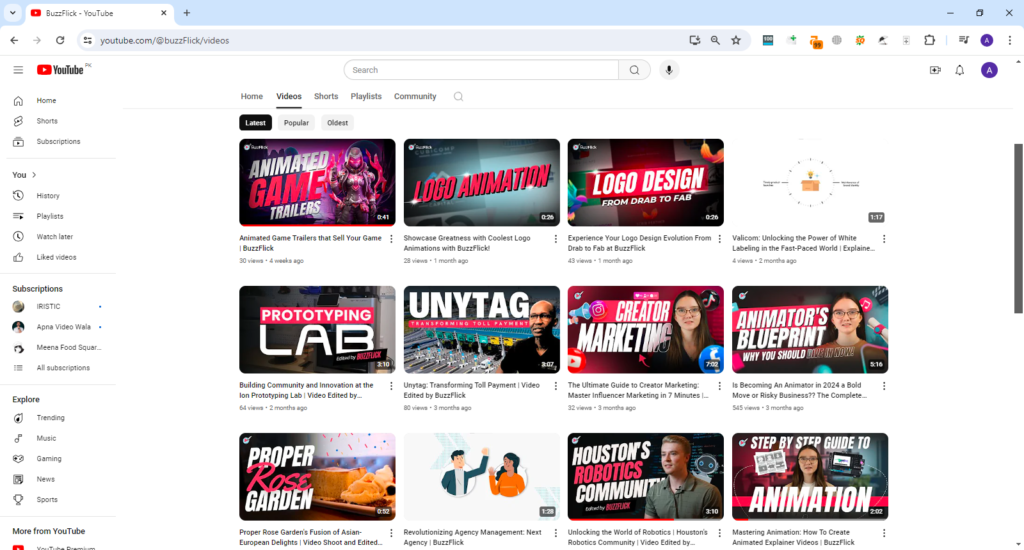Everyday, over 3.7 million videos get posted on YouTube. That’s staggering! The demand for video content is ever-increasing, and it will only grow in the years to come. But, there’s something that’s bothering all website owners. They don’t get to see their videos in search results.
Whatever keyword you put in the search bar, your videos just don’t pop up?
Are they lost? Will they ever be visible to the user? Does Google derank them, or don’t show them to the user? What’s happening?
Well, in this blog post, we’ll answer all your questions. In fact, I really want to see you increase the visibility of your videos in search results. So, I’ll give away five never-told-before tips to not only gain visibility, but actually find your way up the video search results.
So, without further ado, let’s jump right in!
Create a precise video sitemap for navigation
Google and Bing are two of the most popular search engines that host millions of videos. Your objective should be to help these engines navigate your videos in the most efficient way possible. One recommended way to do it is to create a sitemap for your videos.
Google gives preference to results from exclusive video pages, and video sites on its SERPs. So, your best option is to create a dedicated video sitemap. It will tell Google that your page hosts video content, which might otherwise remain undiscoverable by Google’s usual crawling systems.
So, get a video sitemap in place. Next, you need to add the necessary metadata in your ‘.txt’ file.
What to include in a metadata file?
Here are some important things you can include in your video’s metadata file to improve visibility of your video on Google search results.
- Keywords
- Titles
- Duration, and description
Share your videos to a third-party platform
Just like video pages, Google also shows sought-after results from third-party platforms like YouTube and DailyMotion. Posting your videos to these platforms can help you build an exclusive audience base for videos. Having a solid presence on YouTube also helps navigate your user to your video content with a lot of ease.
In addition, YouTube has a massive user base, so posting on YouTube gives you the chance to expose your content to people who’re active users of social media, and would be happy to consume your content. Besides, you can even post videos on DailyMotion, and even Vimeo.
For a more premium and exclusive audience base, you can consider posting your videos to platforms like Wistia, and Dacast. These may be pricey options, but could be suitable for a highly niche-targeted audience of content creators and entrepreneurs..
Improve Video Thumbnail and Copy
Here’s another useful way of improving your visibility in search results. Videos that have more clicks often make it to featured snippet results. To improve your video’s click-through rate, you need an irresistible thumbnail. One that tempts everyone to click.
Keep the thumbnail copy simple while ensuring that the visuals are attractive. Humanize your thumbnail if possible. The words you use in the thumbnail don’t have to be from the video’s title. Just make sure to build a natural connection between the thumbnail and the title.
Pro Tip:
If you’ve strong visuals, keep the copy simple and concise. However, if visuals are ordinary, write compelling copy to trigger action.
Here’s a fine sample from our own YouTube Channel:

For the title, and video description, include useful keywords. You may even search the YouTube Keywords Tool for more trends, and niche-relevant search terms. Keep the description precise. It should be more like a peek into the video, but not the same as the video itself.
Last, but not least, make sure to have a transcription file for your video. Having subtitles for your video shows search engines that you have gone a step further to create your videos. You may use auto-generated subtitles, or hire a transcripter for the job.
In anycase, having an SEO-optimized transcript with user-friendly timestamps will make it easier for the crawlers to index the video content, and show it in SERPs.
If you need complete guidance on how to crack the code for producing quality videos, and boom traffic on them, make sure to consult for professional video marketing services.
Create a dedicated video page on your website
Google shows results from dedicated video pages in its rich results. It is highly likely that a search user will click on the snippet, and land on your website.
Previously people used to manipulate video search results, by embedding videos on their long-form content pages. But, it doesn’t work like that anymore. In fact, now you need a separate video page that features video content only. Text should be minimal at best.
How do you benefit from it?
Create a dedicated video page for your website. Make sure to embed a video player, keeping the video the main content. Most importantly, the video should feature in the top section of the page. As you do that, you can benefit from reposting the same video to your product pages, blog posts, and even landing pages.
Therefore, remember that you need a dedicated video page to get your results in the Rich Snippets section of Google Videos.
You can even share your videos to a third-party video hosting platform like YouTube, DailyMotion, and Vimeo.
Keep an eye on average watch time for your videos
Here’s another important factor that will boost visibility of your video in search: Watch time. The average watch time is one metric that search engines use to rank videos. More importantly, video hosting platforms will only give a push to your video, if it has a higher average watch time.
If you’re just starting out, you should target at least 50% of average watch time. Needless to say, you want each viewer to watch the video till the very end. It’s always desirable.
Moreover, search engines also take into account video formatting, and total views on the video. And, it’s worth knowing that you can improve both, if your average watch time is high.
Most creators struggle with it at the start. And, if you too have no clue how to go about presenting your videos. You’re better off acquiring services for YouTube video production.
A dedicated YouTube video editing service will ensure that your videos have the perfect cliffhangers to grab attention, and make viewers tick till the last second. Plus, there’s a lot they’ll do to help you level up with your videos.
Bonus: How does Google decide when to show videos in the search results?
I don’t think it would be fair to close it with the tips and tricks only. How about we learn more extensively about what Google exactly does to show your videos? What’s working behind the scenes to evaluate your video, and place it on search results?
Let’s find out:
Matching Search Intent
If a user searches for anything related to reels, videos, or documentaries, Google is likely to show videos in the results. It does so to satisfy the search intent of the user.
Compound keywords
For example the user searches the term “explainer”, which has a volume of 1000 monthly searches. Now, if the term “explainer videos” has the volume of 500 monthly searches, it is fair to assume that searchers are looking for videos.
Google will automatically show video results to satisfy the user’s search.
Immediate Query Improvements
For example, if you’ve 1000 users searching for the keyword “brand promos”, and then immediately, 250 out of those 1000 users, improvise their query by adding the word “brand promo videos”, then Google is likely to feature videos in its results.
The algorithms are constantly evolving, and they’ve been swiftly responsive to the user’s search behavior. The best thing you can do is think of user-friendly orientation of results, and perform video SEO accordingly.
Content
This one’s seriously valuable especially if you’re stuck in the middle of whether or not you should make videos about your topic. If you’re confused, search the term on Google. If there’s more text available for the search term, then creating videos won’t bear any fruit. The chances of your video popping up in the SERPs are absolutely slim.
So, if you find more videos for your topic in the results, go after creating one in your brand’s name.
Results show up from Third-party platforms
As mentioned above, Google features results from dedicated video sites and platforms. Video results come from both YouTube, and Daily Motion.
SERP-Bounce
Videos may also show up in results, if Google considers that your videos have a high dwell time. It may rank your videos on top of written content from other sides. It makes sense as more and more people want to watch, and learn through videos.
Wrap up
Let’s wrap this one up.
Above I gave you five exciting tips to increase visibility of your videos in Google search results.
Here’s a summary of what I shared above: Create a separate video page for crawlers to index video content in their library. Improve overall watch time but investing time and effort in your script, and storytelling.
Enhance the quality of thumbnail, description and write a catchy title. Host your videos on third-party platforms to build an audience that loves watching videos. That’s also your chance to build a loyal community of fans who would share, and repost your videos.
FAQs
How do I make my video appear in search results?
To make your video appear in search results, you need to create a video sitemap. It is basically a text file that includes video metadata. It gives more details about your video to the crawler of the search engine. So, once you’ve created sitemaps for your video, make sure to include it in the Google Webmaster tools of your website.
Why is my video not showing up in search results?
Your video might now show up in search for the following reasons: Your video was posted to a blog, or product page only. It’s not originally posted on a dedicated video page, or video sharing platform. Plus, your video may also go missing, if you haven’t optimized it for YouTube SEO. So, make sure to include relevant keywords in your transcript file.
Does Google prioritize video?
Video is increasingly becoming the primary ingredient for all written content that packs an instructional tone of voice. Video is having a direct as well as indirect impact on SERP rankings. Viewers watching videos on your web page add more seconds to the total dwell time of the page, hence satisfying search queries, and ultimately improving search quality.
Do videos improve SEO?
Yes, video content does improve SEO. Videos that get more social shares, easily receive more views, and end up winning feature-rich snippets on search engines. Plus, videos are in high demand today. Viewers consume more videos that text.




